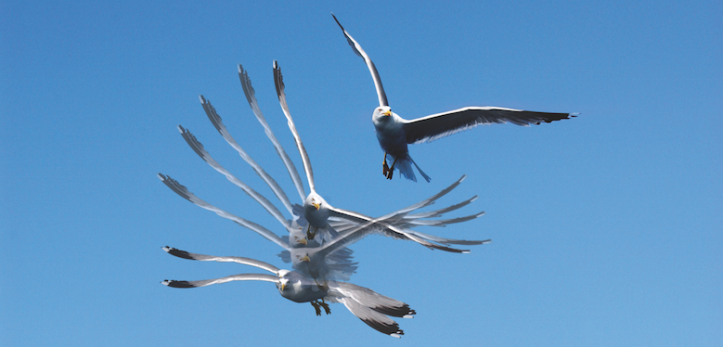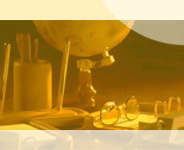тАЬLook at the birds of the airтАЭ (Matt 6:26)
Author: Miros┼Вaw Rucki,
"Love One Another!" 32/2015

In an attempt to deny the very existence of God, atheists refer to the theory of evolution, professing faith in the self-creation of life and its amazing forms. However, their arguments are absurd, their empirical evidence is zero, and the evolutionary scenario contains only fiction, as shown by the alleged evolution of birds.

Rampant imagination
It is easy to say that birds descended from reptiles and that they have developed wings and feathers through evolution. In reality, however, to transform a reptile into a bird is more difficult than to transform a hay wagon into a plane.
I do not want to criticise fellow scientists who profess faith in the gradual evolutionary transformation of reptiles into birds. After all, everyone has the right to believe in whatever they wish. However, I must honestly say that the тАЬscientificтАЭ descriptions of the evolutionary development of birds are more fantastical than the fictitious ancient mythology or fairy tales about the frog who was transformed into a princess.
The тАЬscientificтАЭ descriptions of the evolutionary development of birds are more fantastical than the fictitious ancient mythology or fairy tales
The scientific magazine Current Biology carries a suggestive statement: тАЬDuring the past 30 years novel methods and abundant new data have ever more firmly established the evolutionary relationship between birds and other dinosaursтАЭ (J. Clarke and K. Middleton, тАЬBird EvolutionтАЭ, Current Biology, 19/10 (2009), pp. 350тАУ354). A. M. Heers and K. P. Dial are forced to match this vision to the scientific facts, so they present a seriouslooking summary of hypotheses to explain how dinosaurs began to fly and became birds: they ran on two legs, waving their front legs; they ran and jumped, waving their front legs; they stood and jumped, waving their front legs; they jumped while running, with their front legs outstretched, trying to soar; they climbed a hill and jumped down, waving their front legs or holding them horizontally, imitating gliding. All this can be found in their scientific study published in a majorscientific magazine: тАЬFrom extant is extinct: locomotor ontogeny and the evolution of avian flightтАЭ, Trends in Ecology and Evolution, 27/5 (2012), pp. 296тАУ304. They refer to eightysix other scientific publications, which gives the impression of sound knowledge.
The only problem is the fact that in the world around us we do not see reptiles running and jumping, waving their front legs, pretending to fly, and inevitably falling into the ground due to the absence of feathers and wings. And certainly we do not see any living creature that would grow feathers as a result of such bouncing. Therefore, from a scientific point of view, each of these hypotheses should be rejected as one that does not match any known facts. The products of imagination should not be presented as scientific claims.
Honest scientific analysis compels us to confess faith in God, who designed and made everything that characterises a bird and its amazing ability to fly
The problem with fossils
Fossils do not contain anything that could be regarded as an evolutionary ancestor of birds, as in the case of any other animal existing today. тАЬStrangely enoughтАЭ, all fossils without exception are evolutionary side branches, and none of them is a transitional form. In the article тАЬBird EvolutionтАЭ mentioned above, the authors placed a simplified diagram of the evolutionary chain of birds consisting of twelve missing links and not one existing link. Even more interesting is the тАЬbird phylogenetic treeтАЭ in the article by A. Luochart and L. Viriot тАЬFrom snout to beak: the loss of teeth in birdsтАЭ, Trends in Ecology and Evolution, 26/12 (2011), pp. 664тАУ673. There are twenty-nine taxa representing the тАЬside branchesтАЭ of evolution, thirty-one missing links, no existing links and тАУ most interestingly тАУ a dotted line connecting the birds with their hypothetical evolutionary ancestors.
So even the origin of birds from a hypothetical nonexistent reptile ancestor is so uncertain that it must be marked by a dotted lineтАж
Unfortunately, this double uncertainty does not show in textbooks, encyclopaedias and popular programmes, which present birds as creatures directly derived from reptiles. It seems to me that such a stubborn presentation of fictitious ideas instead of scientifically observed facts is absolutely necessary for one purpose only: to create the impression that the existence of the surrounding world and the living beings in it can be explained by ignoring God the Creator.
Technological problems
However, is it really possible to ignore the brilliant and almighty Creator if we look carefully at how the body of a bird functions? The evolutionary transformation of a reptile into a bird is an impossible construction task, in the same way as the transformation of a perfectly designed Rolls-Royce into a perfect Boeing aeroplane. In a reptile, as in a Rolls-Royce, everything is tailored to fast movement and navigation on the ground. In a bird, as in a Boeing, everything is tailored to fast flight and navigation in the air. You cannot just add wings or a jet engine to a Rolls-Royce and pretend that it has become a Boeing. Likewise, you cannot just stick feathers to a reptileтАЩs legs to make it fly.
Besides, even growing feathers is highly problematic. Evolutionists say that the birdsтАЩ feathers and the reptilesтАЩ scales are homologous, and they pretend that the matter is resolved. In reality, however, the feather is built of hundreds of hooks arranged in such a way that waving the feather down results in greater air resistance than when waving it up. How is this possible? Look at a feather under a microscope, and you will see that it is not possible to make such a high-tech device as a feather from a scale. Simply changing one scale into hundreds of linked hooks is technically impossible (I would not undertake this task, even with all the currently available technological equipment and the worldтАЩs greatest engineering minds at my disposal), not to mention the transformation of genetic information so that instead of a scale the reptile would grow a feather made up of hundreds of those hooks with a complex microstructure. A further problem would be that it is not just one scale that needs to turn into a feather, but all of them.
However, if we think that a reptile whose scales suddenly (or over millions of years) evolved into feathers will start flying by simply jumping up, we are mistaken. One feather is not the same as another one тАУ and if a reptile grew remiges on its bottom and retrices or pulviplumes on his wings, it could jump up to his heartтАЩs delight but would not become a bird.
What is more, a reptile with all its feathers in place still would not fly up. A feathered reptile would run and jump, falling on its beak, but would never fly, just as the best Rolls-Royce would not get far if its engine components, bearings and friction units were not oiled. Friction force is relentless, and no engineer will believe that sliding elements (such as hooks in feathers) will work without lubricant. And we know that not even one reptile, unlike birds, has a sebaceous gland on its back, and even if it had, it would not be able to distribute the lubricant over all the feathers, as birds do (a reptileтАЩs spine is too rigid and does not bend backwards). Evolutionists, however, are not bothered about this. As we have already seen, the facts are less important to them than their exuberant imagination.
Aerodynamic problems
But even if an evolutionary miracle occurred and every scale on the reptileтАЩs body evolved into hundreds of hooks with proper micro-links, everyfeather was in the right place, quite accidentally the sebaceous gland grew on its back and its spine bended so that all the feathers could be lubricated, we would still have only a monster incapable of independent functioning. That monster could not normally run (feathers, especially wings, greatly hinder running), while waiting millions more years to be able to fly тАУ at least that is what the evolutionists teach. For how were blind mutations to know how to shape the profile of the wings to produce lift force? It took a few thousand years for humans, but we accumulated knowledge which was consciously acquired and consciously handed down from generation to generation. However, natural selection does not accumulate knowledge and eliminates individuals who cannot make use of their тАЬupgradesтАЭ generated by random mutations. And certainly wings with the wrong profile have no application value and only hinder, making the winged reptile an easy prey for predators.
But even if random evolution has shaped the profile of wings correctly, our poor little monster still will not fly, and jumping up will hardly help. Aerodynamic formulas demand that wing area be proportionate to weight, so the wings must grow (which for many millions of years will be beneficial to predators, but not to our reptile-bird, which will not survive in the relentless conditions of natural selection) and body weight must decrease. Normal dieting will not work, so we have to wait millions of years for random evolutionary processes to invent the ingenious solution observed in birds: hollow bones! It is difficult to even estimate the probability and the number of years needed, with no harm to the reptile in transforming his heavy, marrowfilled bones into the hollow, rigid and lightweight bones of the bird. For all the similarities between the skeletons of reptiles and birds, there is not one reptile with hollow bones, as in a bird. So our Rolls-Royce will not fly, even if we attach large wings to it. It is simply too heavy, so we would need to replace its suspension with a light and rigid structure.
Drive problems
Yes, a Rolls-Royce has a wonderful drive, perfectly suited to the tasks on the road, but totally unsuitable for flying. The powerful motor spins the wheels, but gives no advantage in the airтАж
Similarly, the reptileтАЩs muscles are great, but they are suitable for running, and not for flying. I do not want to quote all the clever names of the muscles; I will only point out that if reptiles accidentally grew the muscles of birds, they would have a problem with running. Conversely, if a bird had a reptileтАЩs muscular system, it would never fly.
And even if suddenly, for some reason, a reptile gave birth to a bird with feathers, lubricant, hollow bones and even the right muscular system, it would not fly too much.Aftera few beats of its wings, it would run out of oxygen and fall down, simply providing food for scavengers. And here the discussion about the evolution of birds from reptiles should end, because birds have a totally different lung construction from reptiles. The lungs of reptiles, like those of humans, operate on an inhale-exhale scheme (we inhale air into the lungs and immediately exhale it). Birds, however, exhale the air inhaled into the lungs during the previous cycle. Thus the frequencyof inhaling-exhaling in birds is tens of times greater. The transformation of one system into another by means of gradual evolutionary change is impossible. You cannot even imagine an intermediate system, just as there is no intermediate solution between a two-stroke and a four-stroke engine, or between a piston and a jet engine. There is no тАЬcorrective surgeryтАЭ allowing us to convert a two-stroke into a fourstroke engine, and there is no mutation or series of mutations capable of transforming reptilesтАЩ lungs into birdsтАЩ lungs. Although a half-reptile half-bird with half-developed feathers and half-hollow bones could somehow survive and avoid being devoured by a predator, even the most hardened evolutionist must agree that no monster with inefficient lungs in a transitional stage between two-phase breathing and four-phase breathing could survive. Natural selection demands immediate benefits, while transforming a reptile into a bird provides only problems.
The control computer
Scientific fairy tales about jumping dinosaurs which accidentally grew feathers that lifted them into the heavens are good bedtime stories for children, provided that we mention one very significant thing. There is a fundamental difference between the jumps of a reptile and the flight of a bird. Mistakes made in flight will cost the bird its life, so it must have a very sophisticated control system to analyse many facets of flight and to trigger тАУ without fail тАУ appropriate mechanisms controlling flight altitude, stability, change of direction, soaring up and landing in different conditions. It is unlikely that these factors would be known to the unreasoning mutations that might produce another control mechanism before the bird crashed into rocks or fell into water, but scientists who analyse the behaviour of birds in the air should know about them. The British Professor A. McIntosh points out that even тАЬthe tail is no use as a static тАШadd-onтАЩ. It must have the means of altering its shape in flight. All these mechanisms are controlled by a nervous system connected to the on-board computer in the birdтАЩs brain, all pre-programmed to operate within a wide envelope of complicated aerodynamic manoeuvresтАЭ (from In Six Days, ed. J. Ashton, New Holland 1999).
Fossils do not contain anything that could be regarded as an evolutionary ancestor of birds
I just wonder why the existence of this wonderful computer with advanced software running on neural networks тАФ so fashionable currently in science тАФ still fails to persuade some scientists of the existence of the infinitely wise Programmer perfectly familiar with aerodynamic conditions at different heights, the Materials Scientist who chose highly rigid and at the same time lightweight materials for the construction of birdsтАЩ feathers and bones, the Constructor who developed the smallest details to allow birds to fly rather than jump up and down, the Electronic Engineer who invented the data transmission network and the processors to analyse it, the Mechanic who produced lightweight, efficient and reliable implementation systems, the Power Engineer who developed systems for providing, processing and disposing of energy, allowing a bird to maintain constant body temperature and ensuring the long-term high performance of its muscles during flight. It seems that the reason is one: тАЬMany of course refuse to acknowledge the evidence for design in nature because they make the untestable assumption of atheism. [тАж] It is because men do not want to be accountable to a Creator God that they persist with a theory which has little evidence to support itтАЭ (A. McIntosh, ibid).
Responsibility before God
Honest scientific analysis compels us to confess faith in God, who designed and made everything that characterises a bird and its amazing ability to fly. The Creator says: тАЬI know all the birds of the air, and all that moves in the field is mine.тАЭ (Ps 50:11). But were birds on GodтАЩs mind when He created the world? тАЬOf how much more valueare you than the birds!тАЭ the LordJesus tells us (Luke 12:24), and he does not hesitate to shed his blood for our salvation.
The Scripture says: тАЬTherefore, my friends, since we have confidence to enter the sanctuary by the blood of Jesus, by the new and living way that he opened for usтАЭ (Heb 10:19тАУ20), and at the same time it warns us: тАЬHow much worse punishment do you think will be deserved by those who have spurned the Son of God, profaned the blood of the covenant?тАЭ (Heb 10:29)
We have a lot of evidence that God has planned and created this world, and out of his love for us he gave us his only Son, Jesus Christ, тАЬto be the atoning sacrifice for our sinsтАЭ. (1 Jo 4:10). So let us not disregard the facts and let us not believe in fairy tales; let us trust in Christ and not cast away his blood of the covenant, to which we have access in the Eucharist.
Source: https://loamagazine.org/archive/2015/2015-32/look-at-the-birds-of-the-air-matt-626
The article was published with the permission from "Love One Another!" in September 2020.
Submit
your article!
Read
more articles - Free!
Need
translation jobs? Click here!
Translation
agencies are welcome to register here - Free!
Freelance
translators are welcome to register here - Free!
Subscribe
to TranslationDirectory.com newsletter - Free!
Take
part in TranslationDirectory.com poll - your voice counts!
|





